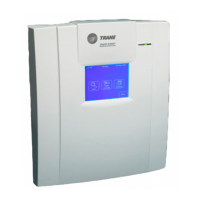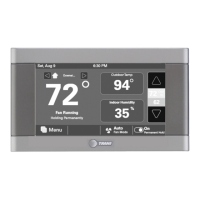Comm3/Comm4 wiring
BMTX-SVN01C-EN 35
Comm3/Comm4 wiring
A Tracer Summit Comm3 and Comm4 wiring is low voltage Class 2 and
must be field-supplied and installed in compliance with NEC and local
codes. The wire must be low-capacitance, 18-gauge, shielded, twisted pair
with stranded, tinned-copper conductors. Wire capacitance (measured in
picofarads/foot [pF/ft] or picofarads/meter [pF/m]) between conductors
must be 23±2 pF/ft (72±6 pF/m). Shielded wire is recommended to pre-
vent electrical noise interference. Approved wire suppliers can be found
in the Trane Buying Group.
Fiber-optic UCM communication is also available where extreme dis-
tance, electrical noise immunity, or building-to-building communication is
required (see “Fiber-optic wiring for Comm3/Comm4 links” on page 39). If
fiber optics are not used for building-to-building communication, a Tran-
stector transient protector, available from suppliers in the Trane Buying
Group, is required at each building.
Comm3/Comm4 configuration requirements
Comm3 and Comm4 wiring must use one of the following configurations:
• Daisy-chain configuration (preferred), shown in Figure 18. Maximum
length is 5,000 ft (1,524 ft).
• Branch configuration (not recommended), shown in Figure 19 on
page 38. Maximum length is 5,000 ft (1,524 ft). The maximum num-
ber of branches is 10.
Comm3/Comm4 wiring, best practices
The following wiring practices are recommended:
• Comm4 links are polarity sensitive, so consistent wiring polarity
must be maintained between devices. Although Comm3 links are not
polarity sensitive, it is good practice to maintain consisting wiring
polarity.
• Strip no more than 2 inches of the outer conductor of shielded cable.
• Daisy-chain configurations are preferred over branch configurations.
• Avoid sharing 24 Vac power between UCMs.
• Ensure that 24 Vac power supplies are consistently grounded. If
grounds are not maintained, intermittent or failed communication
could result.
• Avoid overtightening cable ties and other forms of cable wraps. It
could result in damage to the wires inside the cable.
• In an open plenum, avoid running wires over or close to lighting bal-
lasts, especially those using 277 Vac.
• Do not run communication link wiring in the same conduit or wire
bundle with ac-power wires. Electrical noise may result, which can
make the BCU malfunction or experience communication problems.
• Use the same wire type for all Comm3/Comm4 link wiring.

